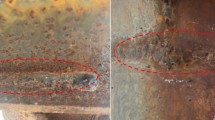Abstract
The impact corrosion-abrasion properties and mechanism of high manganese steel were investigated under different impact energies. The result shows that the wearability of the steel decreases with the increase of the impact energy. The dominant failure mechanism at a lower impact energy is the rupture of extrusion edge along root and a slight shallow-layer spalling. It transforms to shallow-layer fatigue flaking along with serious corrosion-abrasion when the impact energy is increased, and finally changes to bulk flaking of hardened layer caused by deep work-hardening and heavy corrosion-abrasion.
Similar content being viewed by others
References
G T Burstein, K Sasaki. The Birth of Corrosion Pits as Stimulated by Slurry Erosion[J]. Corros. Sci., 2000, 42(5): 841–860
S Zhou, M M Stack, R C Newman. Electrochemical Studies of Anodic Dissolution of Mild Steel in a Carbonate-bicarbonate Buffer under Erosion-corrosion Conditions[J]. Corros. Sci., 1996, 38(7): 1 071–1 084
A Neville, T Hodgkiess. A Study of the Effect of Liquid Corrosivity in Liquid-solid Impingement of a Cast Iron and Austenitic Stainless Steel[J]. Br. Corros. J., 1997, 32(3): 197–207
P Novak, A Macenauer. Erosion-corrosion of Passive Metals by Solid Particles[J]. Corros. Sci., 1993, 35(1–4): 635–640
A Neville, T Hodgkiess, J T Dallas. A Study of the Erosion-Corrosion Behaviour of Engineering Steels for Marine Pumping Applications[J]. Wear, 1995, 186–187: 497–507
M M Stack, J Chacon-Nava, Stott F H. Relations Between the Effects of Velocity and Alloy Corrosion Resistance in Erosioncorrosion Environments at Elevated Temperatures[J]. Wear, 1995, 180: 91–99
B K Prasad, O P Modi, A K Jha, et al. Effects of Some Material and Experimental Variables on the Slurry Wear Characteristics of Zinc-aluminum Alloys[J]. Mater Engng. Perf., 2001, 10(1): 75–80
F Y Lin, H S Shao. Effect of Impact Velocity on Slurry Erosion and a New Design of a Slurry Erosion Tester[J]. Wear, 1991, 143(2): 231–240
A Neville, M Reyes, T Hodgkiess, et al. Mechanisms of Wear on a Co-base Alloy in Liquid-solid Slurries[J]. Wear, 2000, 382(2): 138–150
T C Zhang, X X Jing, S Z Li. Acceleration of Corrosiove Wear of Duplex Stainless Steel by Chloride in 69% H3PO4 Solution[J]. Wear, 1996, 15(2): 253–259
J W Jang, I Iwasaki, J J Moore. Effect of Martensite and Austenite on Grinding Media Wear[J]. Wear, 1988, 122: 285–299
J Heidemeyer. Influence of the Plastic Deformation of Metals During Mixed-friction on Their Chemical Reaction Rate[J]. Wear, 1981 66(6): 379–381
X F Li, H F Ding. Impact-corrosion-wear Property of Low Carbon High Alloy Steel and High Chromium Cast Iron[J]. Transactions of Materials and Heat Treatment, 2003,24(3): 61–65
M Z Huang, D K Shi, Z H Jin. Mechanical Property of Metal[M]. Xi’an: Xi’an Jiao Tong University Press, 1986, 10: 91–94
N P Suh. An Overreview of the Delamination Theory of Wear[J]. Wear, 1977, 44: 1–16
Author information
Authors and Affiliations
Corresponding author
Additional information
Funded by the Doctoral Authorization Point Foundation of Education Ministry of China(No.20040359004) and the Major Project Foundation of Education Office of Anhui Province(No.KJ2007A060)
Rights and permissions
About this article
Cite this article
Du, X., Ding, H., Wang, K. et al. Influence of impact energy on impact corrosion-abrasion of high manganese steel. J. Wuhan Univ. Technol. 22, 412–416 (2007). https://doi.org/10.1007/s11595-006-3412-8
Received:
Accepted:
Issue Date:
DOI: https://doi.org/10.1007/s11595-006-3412-8




